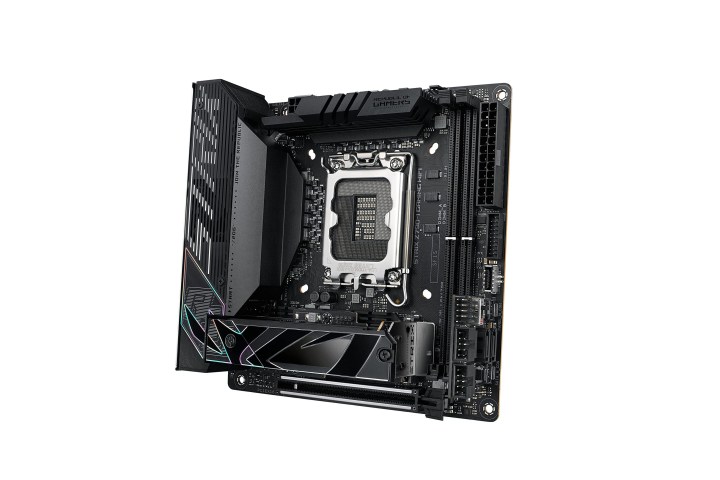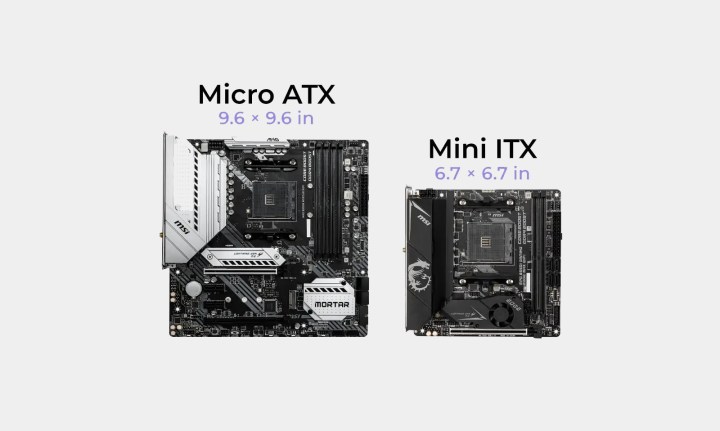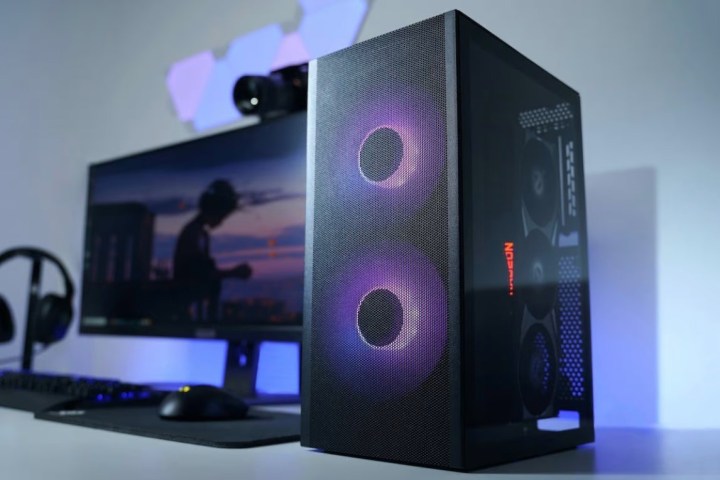Everything you need to know about mini-ITX
The mini-ITX form factor might be niche, but it can save a lot of real estate on your desk. Here's everything you need to know at mini-ITX.

The mini-ITX platform is more popular today than ever. Its compact sizing with high-performance potential makes it great for gamers, content creators, and enthusiasts who seek a small yet capable system. In this guide, we will shed some light and explain everything that you need to know about mini-ITX and how you might want to go about building or buying one in the future.
What is mini-ITX?
Mini-ITX is a small form factor (SFF) standard for motherboards and computer cases that was developed by VIA Technologies in 2001. Its main purpose was to allow for compact and space-efficient computer systems while retaining the basic functionality of a standard desktop computer.
 ASUS
ASUSThe mini-ITX platform is smaller than the more common ATX and micro-ATX standards. Most commonly used mini-ITX motherboards measure 170mm x 170mm (6.7 inches x 6.7 inches) and typically feature a single PCIe expansion slot, two RAM slots, and a variety of I/O ports for USB, SATA, audio, and networking. Despite their small size, mini-ITX motherboards are capable of supporting full-sized CPUs, memory, and storage devices, thus making them suitable for a wide range of computing tasks.
Mini-ITX systems are often used for home theater PCs (HTPCs), compact gaming rigs, office computers, and other applications where space is limited or a small footprint is desired. They have also become quite popular in the DIY and custom PC-building communities due to their flexibility and the creative possibilities they offer for building space-efficient yet powerful systems.
It’s important to note that while mini-ITX motherboards offer space savings, they may have some limitations when it comes to expandability and cooling, especially in comparison to larger form factors like ATX. Additionally, the size constraints can sometimes make it challenging to manage cable routing and achieve efficient cooling solutions within compact mini-ITX cases.
Mini-ITX vs micro-ATX
Mini-ITX and micro-ATX are both SFF standards for motherboards and computer cases, each with its own advantages and considerations. Here’s a quick comparison between the two:
Size and dimensions
Mini-ITX motherboards measure 170mm by 170mm (6.7 inches by 6.7 inches), making them the smallest mainstream motherboard style. They are designed for extremely compact systems where space is a premium. On the other hand, micro-ATX motherboards are larger, measuring around 244mm by 244mm (9.6 inches by 9.6 inches). While still compact compared to the standard ATX form factor, micro-ATX boards provide more room for expansion and features compared to mini-ITX, such as a secondary PCI-Express port.
 Voltcave / Voltcave
Voltcave / VoltcaveBased on these dimensions, you can pick the right case and other components for your system. While there is no well-defined specification, any PC case that offers an internal space of 25 liters or below is considered a mini-ITX chassis. Micro-ATX cases generally have a size that sits between mini-ITX and full-size ATX tower cases, with a few exceptions.
Expansion slots
Mini-ITX boards typically have a single PCIe expansion slot. This limitation can impact your ability to install multiple graphics cards or expansion cards like sound cards or capture cards.
This is not the case with micro-ATX boards, as they usually have more expansion slots, commonly ranging from two to four PCIe slots. This allows for greater flexibility in adding multiple graphics cards, RAID controllers, or other expansion cards.
RAM slots and ports
Mini-ITX boards often have only two RAM slots, limiting the amount of RAM you can install. Similarly, they might have fewer SATA and I/O ports compared to larger form factors. Micro-ATX boards generally offer more RAM slots compared to mini-ITX, allowing for greater memory capacity. They also tend to have more SATA ports, USB ports, and other connectors.
Cooling and build considerations
Due to limited space for heat sinks, fans, and airflow, mini-ITX systems are quite challenging to cool. On top of that, cable management can be a daunting task in smaller cases. Micro-ATX systems often have more room for cooling solutions, larger fans, and better airflow. This can result in potentially better thermal performance and quieter operation.
In short, choosing between mini-ITX and micro-ATX completely depends on your specific requirements and preferences. If you prioritize a very small footprint and are willing to sacrifice some expandability, mini-ITX might be suitable. On the other hand, if you want a bit more room for expansion options and better cooling, micro-ATX could be a better fit.
Why is mini-ITX so expensive?
Buying components for a mini-ITX PC is usually more expensive compared to their larger counterparts. The biggest reason is due to a combination of factors related to design, manufacturing complexity, and niche demand. Here are some reasons why mini-ITX is so expensive:
Engineering and design costs: Designing compact PC parts, for instance, a mini-ITX motherboard, requires specialized engineering to fit all the necessary components into a smaller space. This can involve more intricate circuit layouts, custom components, and additional research and development efforts. Additionally, manufacturing and assembly are more intricate and labor-intensive while the precision required to assemble components in a smaller space can result in higher production costs. Limited market demand: The mini-ITX form factor caters to a specific market niche — enthusiasts, compact PC builders, and those looking for small form factor solutions. The demand is lower compared to standard ATX or even micro-ATX, which can lead to higher manufacturing costs due to economies of scale. Higher quality components: Mini-ITX motherboards have to fit all the necessary components, including the CPU socket, RAM slots, power delivery, expansion slots, and more, into a smaller area. This often requires using smaller and sometimes more expensive components that can handle the higher power demands and heat dissipation challenges associated with the limited space. Features and innovations: Mini-ITX motherboards often pack a range of features to make the most of the limited space available. These features might include improved power delivery, inbuilt- Wi-Fi, M.2 slots, and other innovations. These additional features can contribute to the overall cost. SSUPD
SSUPDDo mini ITX PCs overheat?
Mini-ITX PCs can potentially experience higher temperatures and overheating issues compared to larger form factor PCs due to their compact size and limited airflow. However, whether a mini-ITX PC overheats or not depends on several factors, including the quality of the components, the design of the case, cooling solutions, and the workload the PC is subjected to. Here are some factors to consider:
Case design: The design of the mini-ITX case plays a crucial role in managing heat. Cases with efficient airflow paths, strategically placed vents, and support for proper cooling solutions (like fans or liquid cooling) can help dissipate heat effectively. Do check out our recommendation of some of the best mini-ITX cases. Cooling solutions: Mini-ITX cases often have limited space for cooling solutions, which can lead to higher temperatures. Using efficient cooling solutions, such as low-profile CPU coolers, compact graphics card coolers, and additional case fans, can help mitigate this issue. Component selection: High-performance components generate more heat. When building a mini-ITX system, it’s important to choose components that are suitable for the available space and airflow. Some manufacturers offer specialized mini-ITX versions of components that are designed to handle limited space and thermal challenges. Thermal management: Proper thermal management practices, such as applying thermal paste correctly and ensuring proper contact between the heatsinks and components, are important to optimize heat dissipation. It is also important to understand the airflow path and fan curves to improve cooling inside your mini-ITX case. Workload: The type of tasks your mini-ITX PC is performing will impact temperatures. Intensive tasks like gaming or rendering will generate more heat compared to light web browsing or office work. Room temperature: The ambient temperature of the room in which the PC is located can influence its internal temperatures. A hotter room will likely result in higher internal temperatures. Thus, it is always recommended to keep a mini-ITX PC in a room that has proper air ventilation or preferably an air conditioner. Maintenance: Regular cleaning of the case and components is very crucial for a mini-ITX PC. Doing so helps prevent dust buildup, which can hinder airflow and lead to higher temperatures over time.Want to go even smaller than min-ITX? Why not check out these unique microcomputer builds?

 MikeTyes
MikeTyes 
































